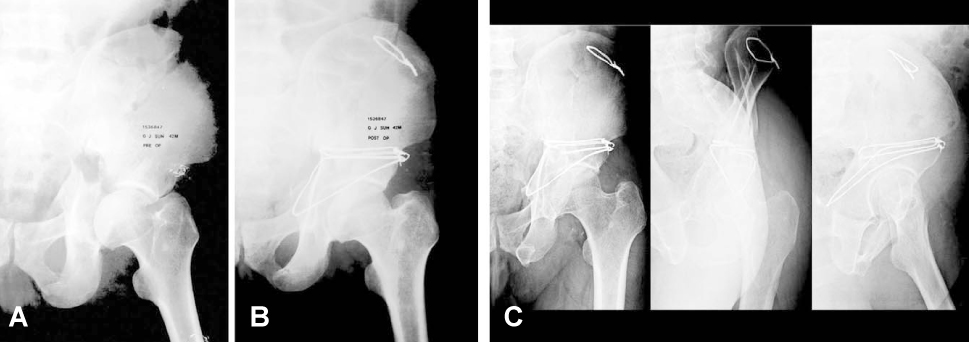J Korean Hip Soc.
2011 Jun;23(2):131-136. 10.5371/jkhs.2011.23.2.131.
Comparative Results of Acetabular Both Column Fracture According to the Fixation Method
- Affiliations
-
- 1Department of Orthopedic Surgery, School of Medicine, Keimyung University, Daegu, Korea. min@dsmc.or.kr
- KMID: 2190724
- DOI: http://doi.org/10.5371/jkhs.2011.23.2.131
Abstract
- PURPOSE
We wanted to compare the clinical and radiological results of surgical treatment of acetabular both column fracture according to the fixation method.
MATERIALS AND METHODS
Between 1986 and 2008, 55 patients who underwent surgical treatment for acetabular both column fracture were clinically and radiologically evaluated after a minimum follow-up of one year. Of 55 patients, 29 cases were operated with a cerclage wire or cable (group I) and 26 cases were operated with a plate and screw (group II). The surgical approach, the intra- and post-operative complications and the reduction quality were compared between the two groups. The clinical and radiological results were analyzed according to the criteria reported by Matta.
RESULTS
There were 14 (48.3%)/20 (76.9%) cases of anatomical reduction, 12 (41.4%)/6 (23.1%) cases of imperfect reduction, 1/0 case of poor reduction and 2/0 cases of surgical secondary incongruence, respectively. Thirty three patients of 34 anatomically reduced patients showed excellent clinical results and the anterior and posterior combined approach was frequent in group I. There were no differences between the two groups for the complications, although intraoperative complication was more frequent in group II and postoperative complication was more frequent in group I.
CONCLUSION
The clinical and radiological results of surgical treatment in patients with both column fracture were satisfactory in both groups. However, the concerns related to the surgical approach and complications will require a randomized prospective study.
Figure
Reference
-
1. Kim SK, Suh SW. Surgical treatment of acetabular fracture. J Korean Soc Fract. 1994. 7:422–430.
Article2. Min BW, Lee KJ. Complications in patients with acetabular fractures treated surgically. J Korean Fract Soc. 2008. 21:341–346.
Article3. Matta JM. Fractures of the acetabulum: accuracy of reduction and clinical results in patients managed operatively within three weeks after the injury. J Bone Joint Surg Am. 1996. 78:1632–1645.4. Min BW, Nam SY, Kang CS. Complications of surgical treatment in patients with acetabular fractures. J Korean Hip Soc. 2000. 12:253–260.5. Gänsslen A, Krettek C. Internal fixation of acetabular both-column fractures via the ilioinguinal approach. Oper Orthop Traumatol. 2009. 21:270–282.6. Kang CH, Lee KJ, Min BW, Jung JH. Indirect reduction of posterior column through ilioinguinal approach in case of both column fractures. J Korean Hip Soc. 2009. 21:334–338.
Article7. Chen CM, Chiu FY, Lo WH, Chung TY. Cerclage wiring in displaced both-column fractures of the acetabulum. Injury. 2001. 32:391–394.
Article8. Kang CS, Min BW. Cable fixation in displaced fractures of the acetabulum: 21 patients followed for 2-8 years. Acta Orthop Scand. 2002. 73:619–624.
Article9. Matta JM. Operative treatment of acetabular fractures through the ilioinguinal approach. A 10-year perspective. Clin Orthop Relat Res. 1994. 305:10–19.
Article10. Matta JM, Anderson LM, Epstein HC, Hendricks P. Fractures of the acetabulum. A retrospective analysis. Clin Orthop Relat Res. 1986. 205:230–240.11. Kim SK, Park JH, Park JW, Hong JS, Kim JH. Significance of anatomic reduction in acetabular fracture. J Korean Soc Fract. 2000. 13:724–732.
Article12. Mayo KA. Open reduction and internal fixation of fractures of the acetabulum. Results in 163 fractures. Clin Orthop Relat Res. 1994. 305:31–37.
Article13. Letournel E. Acetabular fracture: classification and management. Clin Orthop Relat Res. 1980. 151:81–106.14. Yoon TR, Jung SN, Park SJ, Song EK. Internal fixation with pelvic plate for displaced acetabular fracture. J Korean Soc Fract. 2000. 13:733–740.
Article15. Kang CS, Kim SY. The analysis of clinical results of acetabular fractures after open reduction and internal fixation with wire. J Korean Hip Soc. 1989. 1:1–11.16. Kim CK, Jin JW, Yoon JH, Jung SW, Peang JW. Cerclage wiring in internal fixation of displaced acetabular fractures. J Korean Fract Soc. 2008. 21:95–102.
Article17. Letournel E, Judet R. Fractures of the acetabulum. 1993. 2nd ed. NewYork: Springer-Verlag;545–557.
- Full Text Links
- Actions
-
Cited
- CITED
-
- Close
- Share
- Similar articles
-
- Single Percutaneous Retrograde Anterior Column Screw Fixation in a Minimally Displaced Transverse Acetabular Fracture - A Case Report -
- Treatment of Acetabular Column Fractures with Limited Open Reduction and Screw Fixation
- Cerclage Wiring in Internal Fixation of Displaced Acetabular Fractures
- Wire Fixation for Acetabular Fracture: Indication, Advantage and Technique
- Anterior Approach for the Acetabular Fractures



